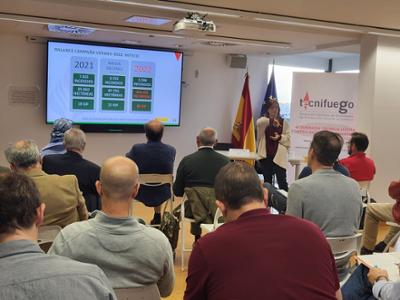

Experts ask that forest fires be made a priority in European policies
Climate change, rural exodus, lack of self-protection plans and inadequate forest management have made fires a key topic which requires the attention of public administrations and citizens. It was in this context that the IV Technical Conference on Forest Fire Fighting was held, in which the experts called for forest fires to be a priority in European policies.
The Conference, which focused on “Fire-Atmosphere Interaction” was organised by TECHNIFUEGO, Asociación Española de Sociedades de Protección contra Incendios (Spanish Association of Fire Protection Societies), and with collaboration from the Ministry for Ecological Transition; the Professional Association of Fire Technicians (APTB); and the Spanish Association for Fighting Forest Fires (ASELF).
During the presentation, Elsa Enríquez, Deputy Director General for Forestry Policy and Combating Desertification, of the Ministry for Ecological Transition, congratulated TECNIFUEGO for convening experts in a monographic conference on forest fires, where a first assessment of the year 2022 will be made. On the other hand, Antonio Tortosa, vice-president of the Association, explained that one of TECNIFUEGO’s goals is educating on fighting fires “a risk which should be put at the centre of debates and decisions”.
Assessment of the Campaign
The first speech “Assessment of the Forest Fire Campaign” was given by Ángela Iglesias, head of the Service of the Fire Defence Area of the Ministry for Ecological Transition, who put forward the provisional data on forest fires in 2022, highlighting that the number of fires has been below the average of the decade, however, in forest area burned and interventions the average has doubled. “The 55 biggest fires in 2022 razed 85% of the total area. 70% of outbreaks did not become proper fires, which gives us an idea of the enormous mobility of the fire-fighting teams and brigades".
Iglesias also reported on the collaboration and coordination between administrations, autonomous communities and the European Union in the fight against fires, highlighting the work of FAST, the Forest Fire Assessment and Advisory Team in the field of civil protection in Europe, "born out of the experience and knowledge in the management of forest fires in Spain and which can support other countries facing this risk".
The next speech focused on “Galica 2022: vision of a large fire from the Advanced Control Post” José Ramón Sánchez Feijoo, official head of the Orense Town Council Firefighting Service and APTB instructor, reported on the roles, planning, and coordination of the Advanced Post in some of the most worrying forest fires of 2022. “The Advanced Control Post’s perspective on a large fire is of a technical nature, and is a question of being as close to the fire as possible, to gain control of the system, distribution of teams, and gathering of the commands of the different operatives quickly and efficiently. In short, coordination actions or modification of the strategy to ensure efficiency, communication, etc.”. Sánchez Feijoo gave several examples of coordination between controls and teams of diverse backgrounds and entities in the most voracious fires, such as in Valdeorras or Quiroga: “In the fire at Valdeorras, 10,000 hectares and 70 homes were burnt, there were not any self-protection plans, there were illegal housing developments....”
Fire-atmosphere interaction
During the conference, focus was placed this year on the Fire-Atmosphere Interaction, and this topic was tackled under the title “Atmospheric instability and violent meteorological phenomena in the fire at Llutxent in August 2018” by Jose Ángel Núñez, head of Climatology at the State Meteorological Agency in the Valencian Community, in which the speaker explained the incident, and the impact of climate in fires: “It is normal that the weather affects the fire; when the dynamic of the fire is what affects the climate is when we find ourselves in 6th generation fires”: The speaker explained that a survey is carried out through a simulation model and a series of factors can be predicted, such as the speed at which fires are triggered, expansion, pyrocumulus, altitude limits, vertical/horizontal currents, thermodynamic structure, temperature, humidity... "These simulation tools are very useful because we can predict how the fire will be triggered, which is why Aemet is developing models that are useful for prevention and extinction".
The programme continued with a speech from David Caballero, forestry engineer and international consultant, which highlighted the impact of climate and the development of very marked temperature anomalies throughout most of the year. "The above-average values in terms of temperature are spreading to northern European countries. In the Mediterranean arc we have had very high temperatures. And these anomalies have reached the United Kingdom, France and Germany. With this climate-meteorological outlook, great care should be taken, however, the lack of prevention and coordination on a European level is alarming, and this year up to 400 fires each day were recorded”.
Caballero reported, using data from France, Portugal, Spain, on the severity of the fires, and drew attention to the great danger posed by extreme phenomena in the lower atmosphere that trigger uncontrollable fires. Another aspect highlighted by this expert is the risk in the urban-forest interface, something unheard of a few years ago but which is gaining dangerous prominence, so it is essential that if the housing developments inside the forest are not closed and removed, at least they should have self-protection plans implemented and maintained.
The series of presentations ended with Marc Castellnou, Fire Inspector of the Generalitat de Catalunya, who was unable to attend or connect to the conference due to a family problem.
Housing developments in the forest
After the conferences the speakers held a round table to discuss some of the key issues which were put forward by Ramon Maria Bosch, coordinator of the TECHNIFUEGO Forest Fire Fighting Committee.
Firstly, the question of “what to do with housing developments that are located in a forest” was tackled. Some of the conclusions reached were that the constructions within the forest should disappear, meanwhile, it is key to reinvent formulas for construction, with fire protection, and pyrophytic gardening, removing Arizona Cypresses; segmenting and having safe refuge spaces, and self-protection plans that are implemented and maintained over time.
Other key aspects for the prevention and protection against forest fires are:
- Forest management, with the global vision of a forestry engineer; with a holistic approach, supported by legislation, and including private land.
- Increase penalties in the case of arsonists, lack of forest clearance and at population boundaries. Promote the safe municipality brand as an alternative/complement to sanctions.
- Demand and help implement self-protection plans with a global vision in municipalities and urbanisations. There should be civil protection technician in each municipality
- Forest-urban interface: facilitate access for emergency services, work on architecture, urban planning and insurance, FUI zones should be segmented.
- Encourage rural development, through grants for caring for and cleaning the forest, grazing as a tool for cleaning, etc.
- Plans for prevention and to raise awareness.
You can find the different speeches here: https://www.tecnifuego.org/iv-jornada-tecnica-lucha-contra-incendios-forestales





